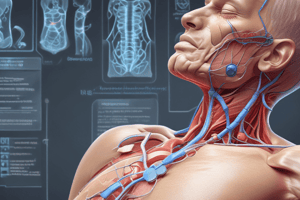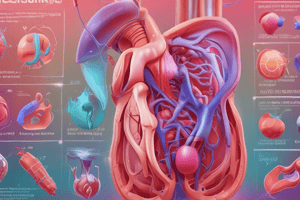Podcast
Questions and Answers
Which condition describes the partial or complete collapse of the lung?
Which condition describes the partial or complete collapse of the lung?
- Pulmonary Edema
- Pulmonary Embolism
- Pleural Effusion
- Atelectasis (correct)
What is the primary purpose of a pulmonary function test?
What is the primary purpose of a pulmonary function test?
- To determine blood gas levels in the body
- To assess lung volumes and airflow (correct)
- To diagnose bacterial infections in the respiratory tract
- To visualize the bronchial tubes
Which symptom is commonly associated with viral pharyngitis?
Which symptom is commonly associated with viral pharyngitis?
- Sore throat (correct)
- Foul breath
- High fever
- Difficulty swallowing
Which procedure involves inserting a needle into the pleural space to remove fluid?
Which procedure involves inserting a needle into the pleural space to remove fluid?
What complication might arise if a pulmonary embolism is not treated promptly?
What complication might arise if a pulmonary embolism is not treated promptly?
Flashcards
Thoracentesis
Thoracentesis
A procedure to remove fluid or air from the pleural space around the lung.
Biopsy
Biopsy
Removal of tissue sample for examination under a microscope to diagnose disease.
Pulmonary Function Test
Pulmonary Function Test
Tests that measure how well the lungs work.
Acid-Base Balance
Acid-Base Balance
Signup and view all the flashcards
Viral pharyngitis
Viral pharyngitis
Signup and view all the flashcards
Study Notes
Thoracentesis
- Purpose: remove fluid or air from pleural space
- Types of fluid/biopsies and their meanings
- Exudative fluid: infection, pulmonary embolism, cancer, trauma, rheumatic disease
- Transudative fluid: CHF, cirrhosis, nephrotic syndrome
- WBC: infection
- Pre-op nursing management
- Consent, pre-medicate
- Assist to proper position
- Educate about procedure
- During procedure nursing management and education
- Maintain position
- Monitor vital signs
- Monitor for signs of distress
- Maintain sterility
- Provide support and education to patient (remain still, avoid coughing)
- Post-op nursing management
- Pain management
- Monitor vital signs
- Frequent respiratory assessments
- Educate patient about signs of infections and complications to report
- Avoid strenuous activity for 24-48 hours
Biopsy
- Purpose: diagnose diseases, infectious agents, guide treatment, presence of cancer
- Post-nursing management (priorities)
- Main management
- Monitor for bleeding and complications
- Infection prevention
- Rest/activity restrictions
- Main management
Thoracoscopy
- Purpose: examine lungs, pleura, and other thoracic structures
- Post-nursing management (priorities)
- Pain management
- Monitor respiratory function complications
- Prevent/monitor for infection
Pulmonary Angiography
- Purpose: visualize blood vessels in lungs
- During nursing management (priorities)
- Consent, monitor vitals
- Contrast injection
- Pain management
- Post-nursing management
- Monitor for bleeding
- Watch for reactions to contrast
- Monitor respiratory status
- Monitor kidney function
- Cultures (e.g., sputum)
Education on obtaining a sample
- Deep breath, then cough
- Easier to obtain in the morning
- Avoid touching container
Pulmonary Function Tests
- Purpose: assess lung function
- Post nursing management
- Monitor for respiratory distress
- Ensure comfort
- Provide education
Bronchoscopy
- Purpose: visualize airways
- Pre/During/Post nursing management (priorities)
- Monitor vital signs and airway
- Assess for complications
Basic Respiratory System Components
- Understand each part, main function, and how it protects the body
- Describe ventilation, perfusion, and diffusion
- Understand what these processes mean in a nursing context
Acid-Base Balance
- pH: 7.35-7.45
- PaCO2: 35-45
- HCO3: 22-28
Recognizing normal/abnormal assessment findings
- Understand terms, definitions, and significance
- Clubbed nails, barrel chest, SOB, lung sounds, etc.
- Priority assessments and related interventions
Recognizing and evaluating respiratory symptoms
- Dyspnea
- Sputum
- Drainage
- RR (rate/effort/rhythm)
Viral pharyngitis
- Symptoms: sore throat, red swollen tonsils, cough, fever, chills, nasal congestion, body aches
- Risk factors: Age (5-15 years), seasonal (fall and winter), weakened immune system, smoking
Bacterial pharyngitis
- Symptoms: similar to viral, difficulty swallowing
- Risk factors: similar to viral
- Severity: mild to moderate, only severe if left untreated, recurrent episodes may lead to chronic conditions
Rhinosinusitis
- Symptoms: nasal congestion, yellow/green drainage, facial pain, pressure, cough, sore throat, fatigue, fever
- Risk factors: upper respiratory infections, allergies
Laryngitis
- Symptoms: hoarseness, dry throat, sore throat, difficulty speaking, cough, mild fever
- Risk factors: Viral/bacterial infections, overuse of voice, allergies, smoking
Care of a patient with Epistaxis (nosebleed)
- Assessments: airway, breathing, signs of shock, frequency of bleeding, underlying conditions, vitals signs
- Interventions: reposition, pinching nose, apply ice, nasal packing
- Medical management: cauterization, topical silver nitrate
- Education: avoid irritants, hydration and humidification
Seasonal allergies
- Treatments: antihistamines, corticosteroids, decongestants, mast cell stabilizers
Tonsillectomy
- Care: pain management, soft diet, oral hydration, bleeding prevention
- Post-operative assessment: airway, bleeding, pain levels, inflammation/infection
Sleep apnea
- Risk factors: Obesity, age (elderly), gender (male), family history, smoking, alcohol, sedative medications, GERD, and HTN
Atelectasis
- Symptoms: decreased breath sounds, tachypnea, dyspnea, tachycardia, cyanosis, hypoxia, coughing, chest pain
- Nursing management: assess respiratory status, O2 management, repositioning, deep breathing, incentive spirometer, encourage mobility, suctioning
Aspiration
- Symptoms: coughing, choking, wheezing or gurgling sounds, SOB, dyspnea, chest pain
- Nursing management: chest X-ray, position upright, airway management (suctioning), oxygen therapy and watch for complications
Pleural effusion
- Accumulation of fluid in the pleural space
Pulmonary Edema
- Symptoms: severe dyspnea/orthopnea, pink frothy sputum, tachypnea, cyanosis, crackles
- Nursing management: raise HOB, oxygen therapy, medications, position changes, fluid restriction, pain relief
Pulmonary embolism
- Symptoms: sudden dyspnea (shortness of breath) / SOB, chest pain, cough, hypoxia, hypotension
- Nursing management: Oxygen therapy, monitor vitals, auscultate, anticoagulants, pain management
Pneumonia
- Symptoms: cough, green/yellow/rusty sputum, dyspnea, fever, chills, tachypnea, crackles, sweetness, sweating
- Nursing management: respiratory assessment, oxygen, antibiotics, pain management, nutrition, and hydration
Chronic Obstructive Pulmonary Disease (COPD) and Asthma
- Chapters 33 (from source) contains information/questions related to COPD and Asthma
Medications
-
Silver Nitrate
-
Ipratropium and albuterol
-
Methylprednisolone
-
Beclomethasone inhaler
-
Afrin (oxymetazoline)
-
Flonase (fluticasone)
Studying That Suits You
Use AI to generate personalized quizzes and flashcards to suit your learning preferences.
Related Documents
Description
This quiz covers essential nursing management practices before, during, and after thoracentesis and biopsy procedures. It includes the purposes of these procedures and important nursing considerations, such as patient education, vital sign monitoring, and post-operative care. Test your knowledge on these critical topics in nursing care.




